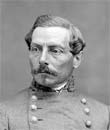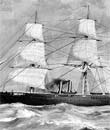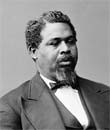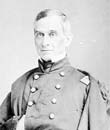
Day-by-Day Timeline of Events
December 20, 1860
South Carolina adopts an ordinance of secession, becoming the first slave state of the south to declare its intent to leave the Union.
December 26, 1860
U.S. Major Robert Anderson evacuates Fort Moultrie and his garrison relocates to Fort Sumter.
December 27, 1860
Confederate troops take over Fort Moultrie as well as Fort Johnson and Fort Pinkney in Charleston Harbor, South Carolina.
January 9, 1861
The steamer "Star of the West", laden with supplies and en route to Fort Sumter in Charleston (South Carolina), is fired upon by land-based cannons.
January 12, 1861
Star of the West, a steamer having delivered supplies to Fort Sumter in Charleston, South Carolina, returns to New York with her battle-damaged hull resulting from a Confederate attack.
April 6, 1861
President Lincoln notifies the government of South Carolina that general supplies will be sent to Fort Sumter at Charleston Harbor - he gives his assurances that any strengthening of the position will only be made if the Fort is in danger of attack.
April 11, 1861

April 12, 1861
With the refusal by Union forces at Fort Sumter to surrender their post, Confederate forces begin their ranged bombardment of the island.
April 12, 1861
At 4:30AM, a gun from Fort Johnson fires a star shell that detonates above Fort Sumter. This is the signal for the surrounding gun batteries to begin shelling the Union-held fort.
April 12, 1861
At 7:00AM, the guns of Fort Sumter return fire against Confederate positions in Charleston Harbor.
April 24, 1861

April 29, 1861
Confederate President Jefferson Davis calls a special session of congress to address recent developments - including the capture of Fort Sumter by South Carolinian forces.
March 15, 1862
To better handle the ongoing war situation covering Florida, Georgia and South Carolina, Union authorities establish the Department of the South.
May 13, 1862

June 16, 1862
The Battle of Secessionville takes place in Charleston, South Carolina. It is a Confederate victory by Nathan Evans and Thomas Lamar. Union General Henry Benham, who had violated orders in the engagement, is arrested
October 22, 1862
Union forces are driven off by defending Confederates at Yemassee in South Carolina.
January 29, 1863
A Confederate supply ship, Princess Royal, is intercepted by Union naval forces near Charleston Harbor, South Carolina.
June 2, 1863
Former slave Harriet Tubman guides Union forces to raid Confederate plantations in the South Carolina Lowcountry. About 750 slaves are freed in the operation and these men strengthen Union numbers by joining their ranks. The raid is recognized as the Raid at Combahee Ferry.
July 18, 1863
Union forces fail to take Fort Wagner. near Charleston, South Carolina. The 54th Massachusetts Regiment taking part in the attack is made up of Negro soldiers, the first of its kind for the Union Army.
August 29, 1863
CSS Hunley, a Confederate submarine, sinks in Charleston Harbor waters (South Carolina) while undergoing diving actions.
September 6, 1863
Under pressure from a Union bombardment, Confederate forces relocate from Fort Wagner in Charleston Harbor, South Carolina.
September 8, 1863
A night time Union naval attack fails to retake Fort Sumter in Charleston Harbor. The attack is directed by Admiral John Dahlgren.
October 15, 1863
CSS Hunley, the famous Confederate submarine, sinks again in Charleston waters. All aboard die in the accident.
February 17, 1864
CSS Hunley becomes the world's first submarine to sink a surface vessel. The target becomes USS Housatonic in Charleston Harbor. However, CSS Hunley is lost in the action.
July 3, 1864
James Island, Charleston Harbor is the site of a successful Confederate defense of Fort Johnson against Union attackers.
July 7, 1864
Another Union attack is beaten back at Charleston, South Carolina, as the defenders continue to deny the important port city to the North.
November 30, 1864
The Battle of Honey Hill is fought in Jasper County, South Carolina, and ends as a Confederate victory despite a force of 1,400 facing 5,000 Union troops.
February 1, 1865
A new march by General Sherman sees his army proceed north into South Carolina and then North Carolina.
February 18, 1865
Castle Pinckney in Charleston Harbor (South Carolina) falls to the South Carolina 21st Colored Infantry of the Union army.
April 29, 1865
President Davis and several of his cabinet meet in Yorkville (York) in South Carolina and plan to relocate the Confederate government headquarters to Texas.


